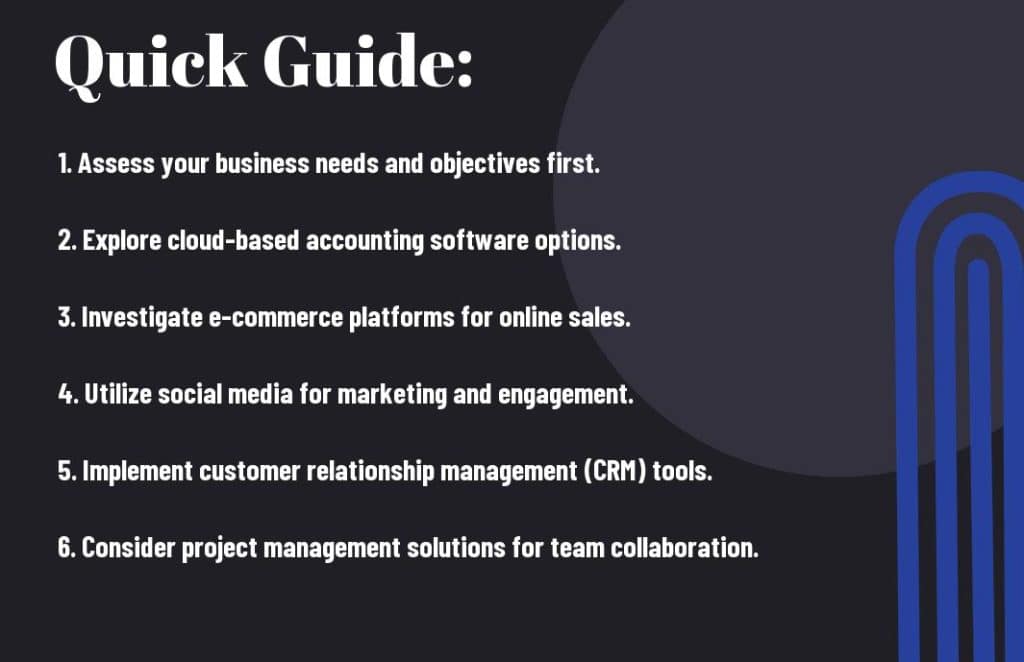What digital solutions are available for small businesses in Australia?
Small businesses can significantly benefit from digital solutions tailored to enhance productivity and streamline operations. In Australia, you have access to a range of tools and services designed to help you manage everything from accounting and customer relations to marketing and e-commerce. This guide will explore various digital solutions available to you, empowering you to make informed decisions that can lead to growth and success in your business endeavors.

Key Takeaways:
- Cloud Computing: Small businesses can leverage cloud services for storage, collaboration, and software tools, allowing for enhanced flexibility and cost-effectiveness.
- eCommerce Platforms: Various established platforms enable small businesses to set up online shops easily, facilitating wider market reach and streamlined sales processes.
- Social Media Marketing: Utilizing social media tools helps small businesses engage with customers, build brand awareness, and promote their products or services effectively.

Types of Digital Solutions for Small Businesses in Australia
To thrive in today’s market, you can leverage various digital solutions tailored for small businesses in Australia. Options include:
| Website Builders | Build an online presence easily and affordably. |
| E-commerce Platforms | Facilitate online sales and manage inventory efficiently. |
| Social Media Marketing Tools | Enhance engagement and reach with targeted campaigns. |
| Cloud-Based Software | Streamline operations and enhance productivity. |
| Customer Relationship Management (CRM) | Improve customer interactions and retention. |
After exploring these options, you can identify which solutions align with your business objectives.
E-commerce Platforms
Businesses can benefit significantly from e-commerce platforms that allow you to set up and manage online stores effortlessly. These platforms simplify everything from product listings to payment processing, enabling you to reach a wider audience without the high overhead costs associated with physical stores.
Cloud-Based Software
Even in a rapidly changing business landscape, cloud-based software provides you with versatile tools for operation management, from accounting to inventory tracking. These solutions allow for real-time collaboration and access to important data from anywhere.
Australia has seen a significant rise in the adoption of cloud-based software among small businesses due to its flexibility and scalability. You can adapt to changing market demands without the need for heavy upfront investment in IT infrastructure. Many options are subscription-based, providing you with the ability to pay for only what you use, while offering important features such as data security and backup, making your operations more resilient.
Tips for Choosing the Right Digital Solutions
Even when faced with numerous digital options, selecting the right solutions for your small business can be streamlined by following a few key tips:
- Identify your primary business goals.
- Research available tools and their features.
- Seek recommendations from other small business owners.
- Consider the ease of use and customer support.
Knowing your specific needs and how each solution aligns with them will guide you in making the best choice for your business.
Assessing Business Needs
Little steps can make a big difference in assessing your business needs. Start by evaluating what specific challenges you’re trying to address and the outcomes you wish to achieve. Engaging your team and gathering feedback can provide valuable insights into operational pain points and opportunities for improvement.
Budget Considerations
With an array of digital solutions available, budgeting wisely is imperative. Evaluate the cost associated with each tool, including subscription fees, implementation costs, and potential hidden charges. Prioritizing solutions that offer the most value without compromising quality is key.
It’s important to calculate your return on investment when considering digital solutions. Analyze how a particular tool will impact efficiency, customer engagement, and revenue generation. By doing so, you can make informed decisions that align with your financial capabilities while maximizing your business’s growth potential.
Step-by-Step Implementation of Digital Solutions
Keep your digital transformation structured by following a precise implementation plan. Below is a simple guide to facilitate your process:
| Step | Action |
|---|---|
| 1 | Identify your business needs and the digital solutions that can address them. |
| 2 | Develop a detailed strategy, including budget and timeline. |
| 3 | Implement the chosen solutions in phases for ease of management. |
| 4 | Guide your team through the new processes and provide training as necessary. |
| 5 | Assess performance and make adjustments based on feedback. |
Planning and Strategy
You need to start by assessing your current business processes and identifying areas for improvement. This planning phase is vital for determining which digital solutions align with your objectives. Craft a comprehensive strategy that encompasses your budget, timeline, and specific goals, ensuring that your roadmap is clear and actionable.
Execution and Monitoring
Monitoring your implementation is vital for success. Execute your strategy methodically, focusing on one solution at a time while tracking progress against your milestones. Engage your team to gather insights and encourage feedback during this stage.
The right execution involves deploying digital solutions effectively while systematically collecting data to evaluate their impact. You should consistently monitor performance indicators and adapt your approach as necessary, ensuring that the solutions continue to meet your business needs. This iterative process will foster continuous improvement and facilitate a data-driven environment for decision-making.
Factors Influencing the Success of Digital Solutions
Now, the success of digital solutions in your small business can hinge on several factors. Understanding these can help you make informed decisions:
- Alignment with your business goals
- Budget constraints
- Implementation and training efficiency
- Integration with existing systems
- Customer feedback and adaptability
This creates a solid foundation for leveraging digital solutions effectively.
Market Trends
Little has changed in the digital landscape, as trends continue to shape how small businesses operate. Embracing automation, focusing on data analytics, and enhancing online presence are key ways to keep pace with evolving market demands.
Customer Preferences
With shifting consumer behaviors, understanding customer preferences is imperative for your digital strategies. As customers increasingly rely on digital channels for engagement and shopping, tailoring your approaches to match their expectations can enhance loyalty and satisfaction.
Customer preferences are shaped by convenience, personalization, and responsiveness. You should take the time to analyze and adapt to these preferences, ensuring your digital solutions prioritize user experience and provide the seamless interactions that your customers desire. By focusing on what matters to them, your efforts will not only meet expectations but also foster a deeper connection with your audience.
Pros and Cons of Digital Solutions
Your journey into digital solutions comes with its share of benefits and drawbacks. Understanding these can help you make informed decisions tailored to your small business.
| Pros | Cons |
|---|---|
| Increased efficiency | Initial costs |
| Improved customer engagement | Learning curve |
| Access to a wider audience | Dependence on technology |
| Data-driven decision making | Cybersecurity risks |
| Scalability | Potential for technical issues |
Advantages for Small Businesses
Advantages of digital solutions for small businesses include enhanced operational efficiency and the ability to reach new markets with minimal investment. They enable you to engage with your customers effectively and make informed decisions based on data analytics, ultimately driving growth and profitability.
Potential Challenges
Even though digital solutions offer numerous benefits, they also present challenges, such as initial costs and the need for ongoing technical support. Navigating the digital landscape can be daunting, especially if you lack experience or resources.
Another challenge you may face is the constant evolution of technology, which requires you to continuously update your systems and train your staff. Moreover, balancing innovation with budget constraints can be overwhelming, making it vital to choose solutions that truly fit your business needs. Ensuring cybersecurity and managing potential technical issues are also critical factors to consider as you adopt new technologies.
Summing up
With this in mind, small businesses in Australia have access to a range of digital solutions designed to streamline operations and enhance customer engagement. You can leverage e-commerce platforms, social media marketing tools, and cloud-based software for accounting, project management, and customer relationship management. Additionally, adopting digital payment solutions and utilizing data analytics can help you make informed decisions that drive growth and efficiency. Embracing these technologies will not only improve your business operations but also keep you competitive in a rapidly evolving marketplace.
FAQ
Q: What types of digital marketing solutions can small businesses in Australia utilize?
A: Small businesses in Australia can leverage various digital marketing solutions to enhance their online presence. These include social media marketing, which allows businesses to engage with customers on platforms like Facebook, Instagram, and LinkedIn. Additionally, search engine optimization (SEO) can help improve website visibility on search engines, driving organic traffic. Email marketing is another effective solution for reaching customers directly and nurturing leads. Furthermore, pay-per-click advertising (PPC) enables businesses to target specific demographics and increase website traffic through sponsored ads on search engines and social media platforms.
Q: Are there any digital financial management tools available for small businesses in Australia?
A: Yes, several digital financial management tools cater to the needs of small businesses in Australia. Accounting software such as Xero and MYOB can help businesses manage invoices, track expenses, and generate financial reports. Furthermore, cloud-based solutions allow for easy access to financial data from anywhere. Payment processing platforms like Square and PayPal offer simple ways for businesses to handle transactions efficiently. Additionally, budgeting tools and financial forecasting software can assist in planning for future expenses and growth, ensuring that small businesses can maintain healthy cash flow.
Q: What e-commerce solutions are available for small businesses looking to sell online in Australia?
A: Small businesses in Australia have access to a variety of e-commerce solutions to facilitate online sales. Platforms such as Shopify and WooCommerce provide customizable online stores that are easy to set up and manage. These platforms often come with secure payment gateways and marketing tools to help businesses reach a wider audience. Additionally, marketplaces like eBay and Amazon offer small businesses an established platform to sell products with a built-in customer base. Overall, these solutions allow businesses to broaden their reach and generate sales through online channels, contributing to their growth and success.
Source article: https://smallbiztoolbox.com.au/what-digital-solutions-are-available-for-small-businesses-in-australia/









